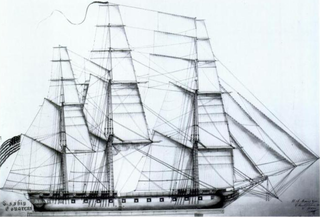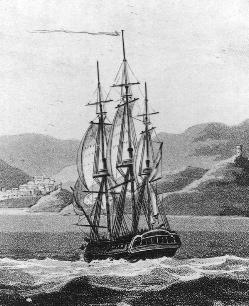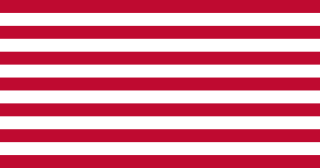
The Norfolk Naval Shipyard, often called the Norfolk Navy Yard and abbreviated as NNSY, is a U.S. Navy facility in Portsmouth, Virginia, for building, remodeling and repairing the Navy's ships. It is the oldest and largest industrial facility that belongs to the U.S. Navy as well as the most comprehensive. Located on the Elizabeth River, the yard is just a short distance upriver from its mouth at Hampton Roads.

USS United States was a wooden-hulled, three-masted heavy frigate of the United States Navy and the first of the six original frigates authorized for construction by the Naval Act of 1794. The name "United States" was among ten names submitted to President George Washington by Secretary of War Timothy Pickering in March of 1795 for the frigates that were to be constructed. Joshua Humphreys designed the frigates to be the young Navy's capital ships, and so United States and her sisters were larger and more heavily armed and built than standard frigates of the period. She was built at Humphrey's shipyard in Philadelphia, Pennsylvania and launched on 10 May 1797 and immediately began duties with the newly formed United States Navy protecting American merchant shipping during the Quasi-War with France.

The first USS Raritan was a wooden-hulled, three-masted sailing frigate of the United States Navy built at the Philadelphia Navy Yard, laid down in 1820, but not launched until 13 June 1843, sponsored by Commodore Frederick Engle. She was one of the last sailing frigates of the United States Navy.

USS Columbus was a 92-gun ship of the line in the United States Navy. Although construction of the warship was authorized by Congress on 2 January 1813, plunder of the Washington Navy Yard by British troops in 1814 during the burning of Washington, combined with efforts to keep US military stores out of British hands, led to the destruction of any initial framing. Days after Congress re-authorized the vessel on 29 April 1816, a keel was laid and construction resumed.

USS Pennsylvania was a three-decked ship of the line of the United States Navy, rated at 130 guns, and named for the state of Pennsylvania. She was the largest United States sailing warship ever built, the equivalent of a first-rate of the British Royal Navy. Authorized in 1816 and launched in 1837, her only cruise was a single trip from Delaware Bay through Chesapeake Bay to the Norfolk Navy Yard. The ship became a receiving ship, and during the American Civil War was destroyed.

USS Congress was a nominally rated 38-gun wooden-hulled, three-masted heavy frigate of the United States Navy. James Hackett built her in Portsmouth New Hampshire and she was launched on 15 August 1799. She was one of the original six frigates whose construction the Naval Act of 1794 had authorized. The name "Congress" was among ten names submitted to President George Washington by Secretary of War Timothy Pickering in March 1795 for the frigates that were to be constructed.Joshua Humphreys designed these frigates to be the young Navy's capital ships, and so Congress and her sisters were larger and more heavily armed and built than the standard frigates of the period.

USS Philadelphia, a 1240-ton, 36-gun frigate, was the second vessel of the United States Navy to be named for the city of Philadelphia. Originally named City of Philadelphia, she was built in 1798–1799 for the United States government by residents of that city. Funding for her construction was raised by a drive that collected $100,000 in one week, in June 1798. She was designed by Josiah Fox and built by Samuel Humphreys, Nathaniel Hutton and John Delavue. Her carved work was done by William Rush of Philadelphia. She was laid down about November 14, 1798, launched on November 28, 1799, and commissioned on April 5, 1800, with Captain Stephen Decatur, Sr. in command. She was captured by Barbary pirates in Tripoli with William Bainbridge in command. Stephen Decatur led a raid that burned her down, preventing her use by the pirates.

A gunboat is a naval watercraft designed for the express purpose of carrying one or more guns to bombard coastal targets, as opposed to those military craft designed for naval warfare, or for ferrying troops or supplies.

USS Constellation was a nominally rated 38-gun wooden-hulled, three-masted frigate of the United States Navy.

The Continental Navy was the navy of the Thirteen Colonies during the American Revolutionary War. Founded on October 13, 1775, the fleet developed into a relatively substantial force throughout the Revolutionary War, owing partially to the substantial efforts of the Continental Navy's patrons within the Continental Congress. These Congressional Patrons included the likes of John Adams, who served as the Chairman of the Naval Committee until 1776, when Commodore Esek Hopkins received instruction from the Continental Congress to assume command of the force.

Steam frigates and the smaller steam corvettes, steam sloops, steam gunboats and steam schooners, were steam-powered warships that were not meant to stand in the line of battle. The first such ships were paddle steamers. Later on the invention of screw propulsion enabled construction of screw-powered versions of the traditional frigates, corvettes, sloops and gunboats.

Chesapeake was a 38-gun wooden-hulled, three-masted heavy frigate of the United States Navy. She was one of the original six frigates whose construction was authorized by the Naval Act of 1794. Joshua Humphreys designed these frigates to be the young navy's capital ships. Chesapeake was originally designed as a 44-gun frigate, but construction delays, material shortages and budget problems caused builder Josiah Fox to alter his design to 38 guns. Launched at the Gosport Navy Yard on 2 December 1799, Chesapeake began her career during the Quasi-War with France and later saw service in the First Barbary War.

Nicholas Biddle was one of the first five captains of the Continental Navy, which was raised by the Continental Congress during the American Revolutionary War. Biddle was born in Philadelphia in 1750. He began sailing at the age of 13 and joined the Royal Navy when he was 20. In 1773, he sailed the Arctic with Constantine Phipps and Horatio Nelson. When the Revolutionary War began in 1775, Biddle joined the Continental Navy and commanded several ships. In 1778 off the coast of Barbados, Biddle confronted HMS Yarmouth, a 64-gun British warship. After a twenty-minute battle, Biddle's ship Randolph suddenly exploded, killing him and most of his men. Four ships of the U.S. Navy have been named in his honor.

Joshua Humphreys was an American ship builder and naval architect. He was the constructor of the original six frigates of the United States Navy and is known as the "Father of the American Navy".

The United States Congress authorized the original six frigates of the United States Navy with the Naval Act of 1794 on March 27, 1794, at a total cost of $688,888.82. These ships were built during the formative years of the United States Navy, on the recommendation of designer Joshua Humphreys for a fleet of frigates powerful enough to engage any frigates of the French or British navies, yet fast enough to evade any ship of the line.

The first USS Randolph was a 32-gun frigate in the Continental Navy named for Founding Father Peyton Randolph, the president of the First Continental Congress. Attaining only moderate success in her career, Randolph was destroyed by an explosion of her gunpowder stores during a naval action on 8 March 1778.

Henry Eckford was a Scottish-born American shipbuilder, naval architect, industrial engineer, and entrepreneur who worked for the United States Navy and the navy of the Ottoman Empire in the early 19th century. After building a national reputation in the United States through his shipbuilding successes during the War of 1812, he became a prominent business and political figure in New York City in the 1810s, 1820s, and early 1830s.

John Lenthall was an American shipbuilder and naval architect. He was responsible for the construction and repair of United States Navy ships during the American Civil War (1861–1865), as well as in the years immediately before and after it. His career spanned the U.S. Navy's transition from sail to steam propulsion and from wooden ships to ironclads, and in retirement he participated in early planning for an eventual steel navy.

















